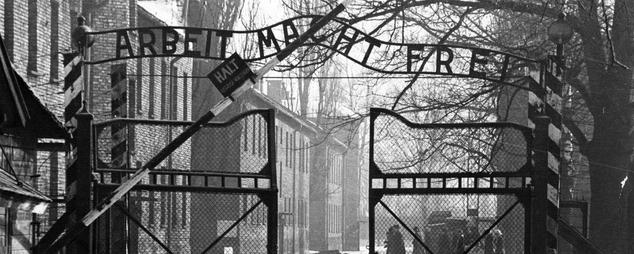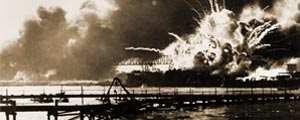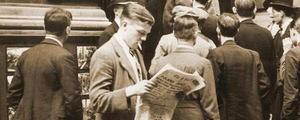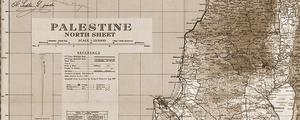Americans and Holocaust, an exhibition that incorporates much of the polling information discussed here, opens at the U.S. Holocaust Memorial Museum in Washington, D.C., on April 23, 2018.
Americans rarely agree as overwhelmingly as they did in November 1938. Just two weeks after Nazi Germany coordinated a brutal nationwide attack against Jews within its own borders -- an event known as "Kristallnacht" -- Gallup asked Americans: "Do you approve or disapprove of the Nazi treatment of Jews in Germany?" Nearly everyone who responded -- 94% -- indicated that they disapproved.
Yet, even though nearly all Americans condemned the Nazi regime's terror against Jews in November 1938, that very same week, 72% of Americans said "No" when Gallup asked: "Should we allow a larger number of Jewish exiles from Germany to come to the United States to live?" Just 21% said "Yes."
Why this yawning gap between disapproval of the Nazi regime's persecutions and a willingness to aid refugees? Gallup polling on these topics during the Nazi era helps answer this question, providing important context for understanding Americans' responses to the threat of Nazism.
Americans' widespread disapproval of the Nazi regime's treatment of Jews could not necessarily be assumed in 1938, given evidence that the U.S. was not immune from its own xenophobia and discrimination.
Prejudice against Jews in the U.S. was evident in a number of ways in the 1930s. According to historian Leonard Dinnerstein, more than 100 new anti-Semitic organizations were founded in the U.S. between 1933 and 1941. One of the most influential, Father Charles Coughlin's National Union for Social Justice, spread Nazi propaganda and accused all Jews of being communists. Coughlin broadcast anti-Jewish ideas to millions of radio listeners, asking them to "pledge" with him to "restore America to the Americans."
Further to the fringes, William Dudley Pelley's Silver Legion of America ("Silver Shirts") fashioned themselves after Nazi Stormtroopers ("brownshirts"). The German American Bund celebrated Nazism openly, established Hitler Youth-style summer camps in communities across the United States and hoped to see the dawn of fascism in America.
Even if the Silver Shirts and the Bund did not represent the mainstream, Gallup polls showed that many Americans held seemingly prejudicial ideas about Jews. A remarkable survey conducted in April 1938 found that more than half of Americans blamed Europe's Jews for their own treatment at the hands of the Nazis. This poll showed that 54% of Americans agreed that "the persecution of Jews in Europe has been partly their own fault," with 11% believing it was "entirely" their own fault. Hostility to refugees was so ingrained that just two months after Kristallnacht, 67% of Americans opposed a bill in the U.S. Congress intended to admit child refugees from Germany. The bill never made it to the floor of Congress for a vote.
Reluctance to admit refugees most likely resulted in part from the profound economic insecurity that typified the times. During the 1930s, nothing captured Americans' attention more than the devastating Great Depression, and hunger and employment took precedence over concerns about the rise of fascism abroad and its victims.
The Great Depression was in its eighth year when the U.S. economy bottomed out again in 1937, the year before Kristallnacht. Unemployment spiked to 20% in 1938, and nearly half of Americans believed the United States had not yet hit the low point of the Depression. The notion that "those refugees" would take "our" jobs prevailed across much of America, even though courageous individuals like Secretary of Labor Frances Perkins tried to convince colleagues in the federal government that immigration would spark economic recovery rather than slow it down. Even as late as the spring of 1939, with war pressures building in Europe, Americans were more likely to say economic issues were the most important problem facing the U.S. than they were to mention war.
This economic insecurity no doubt helped to intensify anti-immigrant sentiment that dated back to the 1920s. By the time Americans became aware of the refugee crisis facing Europe's Jews, America's "golden doors" for immigrants had been all but closed for nearly 15 years, ever since the U.S. Congress passed the 1924 National Origins Quota Act.
The immigration process was designed to be exclusionary and difficult. In that regard, it "worked." Most of Europe's Jews who were unable to find haven from Nazism -- whether in the U.S. or elsewhere -- did not survive the Holocaust. During the 12 years of Nazi rule, historians estimate that the U.S. admitted somewhere between 180,000 and 220,000 Jewish refugees -- more than any other nation in the world, but far fewer than it could have under existing immigration laws.
Prevailing sentiment against admitting refugees reflected the United States' consistent desire to remain isolated from world affairs. President Franklin Roosevelt, harkening back to George Washington's 1796 farewell address, promised Americans that the nation would remain "unentangled." That's what Americans wanted to hear. The U.S. stayed out of conflicts such as the Spanish Civil War, just as Americans hoped it would.
Hindsight tells us that preparing for and fighting in World War II lifted the country out of the Depression, but polling reveals much more pessimism about the prospects for the war before the U.S. entered it. Even in July 1941, as the majority of Americans believed U.S. entrance into the war was inevitable, 77% thought the war would be followed by another economic depression.
Americans remained reluctant to go to war against Nazism partly because of the lessons they took away from intervening in World War I, when some 116,000 Americans were killed. Even in 1941, with all of Europe at war and the U.S. on the brink of entry, about four in 10 Americans still believed that intervention in World War I had been a mistake.
War in Europe began during the first week of September 1939, when Nazi Germany invaded Poland; in response, both Great Britain and France declared war on Germany. Nearly half (48%) of Americans responding to a Gallup poll that week said the U.S. should not get involved, even if it looked like England and France were losing. Roosevelt took to the airwaves that week either to reinforce or to follow public opinion, declaring that the U.S. would "remain a neutral nation."
Nine months later, as France and other Western European nations fell to Nazi Germany, 79% of Americans in a Gallup poll said if they had the chance, they would vote to stay out of the war, and by the summer of 1941, almost eight out of 10 Americans continued to say they did not want the U.S. to enter the war.
All of this concern about the economy and the desire to avoid getting entangled in world affairs -- particularly another European war -- almost certainly played a part in Americans' reluctance to favor bringing Jewish refugees into the country.
A final piece of important context: In 1938, it was not yet clear to anyone that Nazi Germany's persecution of Jews within its own borders would lead to the mass murder of Jews throughout all of Europe. The Nazi regime itself still had not devised that plan at Kristallnacht; murder would become Germany's "Final Solution to the Jewish question" in 1941.
Even during World War II, as the American public started to realize that the rumors of mass murder in death camps were true, they struggled to grasp the vast scale and scope of the crime. In November 1944, well over 5 million Jews had been murdered by the Nazi regime and its collaborators. Yet just under one-quarter of Americans who answered the poll could believe that more than 1 million people had been murdered by Germans in concentration camps; 36% believed that 100,000 or fewer had been killed.
Only with the benefit of hindsight can we connect dots that many Americans could not have at the time. And yet, the stark contrast of these two November 1938 polls, revealing the troubling gap between disapproval of Nazism and willingness to admit refugees, continues to resonate. These findings not only shine a disturbing light on Americans' responses to atrocities during the Holocaust but also are consistent with polls conducted since. A Gallup poll just after the war still showed solid opposition to allowing European refugees fleeing their war-torn continent to come to the United States, and Gallup polls in the decades since have shown Americans' continuing reluctance to accept refugees from other nations.





